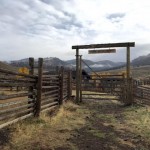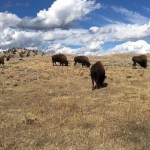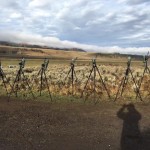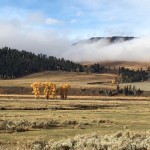
Yellowstone National Park
Oh Give me a home where the buffalo roam” goes the old cowboy song, but the fact that 21st century citizens can still enjoy the star of this song was a very close call. According to the U S Fish and Wildlife Service estimates of the North American bison population at the time of European contact range from 30-75 million animals. However, by 1900 intensive hunting and a purposeful program of eradication to deprive American Indians of their livelihood had reduced the population to near extinction. At that time Yellowstone National Park counted only 25 bison in residence. Thanks to a citizen’s campaign, Congress allocated funds to purchase 21 additional animals from private sources and begin a breeding program at what is now known as the Lamar Ranch in the park’s Lamar Valley.

Yellowstone National Park
This is a success story. Today over 4,000 bison roam the range in Yellowstone National Park and they are a character defining part of the landscape. The evocative Lamar Buffalo Ranch, with its quintessential weathered western buildings (1905- 1930), is listed in the National Register of Historic Places. Visitors who stop by the ranch can get a short history from an interpretive sign. But less well known, is the role the ranch played in the reintroduction of wolves to the park.
The last wolf pack in Yellowstone National Park was eliminated in 1926. Again after a long campaign and much controversy, Congress appropriated the funds for a reintroduction program. In 1995, thirty-one Canadian Grey Wolves were brought to pens at the Lamar Buffalo Ranch to acclimatize to the park before being released. Today there are approximately 100 wolves in the park with many of the packs concentrated in the rich hunting ground of the Lamar Valley. The ripple effect on the elk herd specifically and the park’s ecosystem overall of the introduction of a top predator is fodder for another story at another time.

Yellowstone National Park
I would like to make a different point. Millions of tourists come to Yellowstone every year. Thousands of them line the roads through the Lamar Valley – getting up at dawn and watching for hours to marvel at herds of buffalo and to catch a glimpse of a wolf. The Lamar Buffalo Ranch now serves as an education center for the Yellowstone Association and the buildings have been restored as models of off the grid environmental stewardship. But I wonder how many understand the full story of human intervention into this place. Preventing the American Bison from disappearing from this landscape took intense effort. As for the Lamar Buffalo Ranch, the park web site describes the work that took place there in the following terms, “ A program to raise bison like domestic cattle in Yellowstone may seem incongruous and unnecessary in retrospect..” I am not sure that is how I would tell the story. Yes, yes the vista of grazing herds in the Lamar Valley may seem so natural us today that we may think it always looked that way. And yes, we may want to repress the role that humans played in wrangling bison back into the landscape, let alone the tale of how we slaughtered the millions. But that would be a mistake.

Yellowstone National Park
And as for the wolves, the reintroduction is still so controversial that the park’s web site looks like the docket of a small claims court of environmental justice where wolves are listed and delisted as endangered species with head snapping frequency. The role of the Lamar Buffalo Ranch in the wolf story has not yet even made into the official history. But when you go to Yellowstone (and I hope you will) head to the Lamar Valley, stand in front of the ranch, and contemplate the role we as humans have played in creating and almost destroying the wildlife that we enjoy today. And know that nothing is static, and only continued advocacy and at times active intervention will conserve these landscapes for future generations. .



One Response
Brenda, as a kid I lived at Lamar twice, in 1948 and 1949. My dad was the ranger, and there was a wrangler living in a bunkhouse. There was a corral, a squeeze Shute, a rifle tower, and a butchering building. A large part of the valley was laced with irrigation ditches. The valley was in reality a hayfield.
In late summer a contract haying operation came in and cut and baled hay from dawn to dark, stacking the hay bales near the corral.
As summer turned to fall, the bison herd was driven to the corral. The herd was culled to about 400 head. Those culled out were driven one by one into the squeeze shute which held them still while the rifleman in the tower killed them. The shute was th n released, the bison dropped into the slaughter house and skinned and cut up into meat, all trucked off to American Indian tribes.
The hay was used to feed the remaining 400 through the winter, keeping the herd from migrating out of the park.
Yes, the herd was “ranched” until, I believe, sometime in the the early 1950s.
The corral, squeeze shute and slaughterhouse are all gone. Kind of a shame, because they would make a wonderful basis for an historical exhibit telling The whole story from first efforts to save native bison to ranching the herd to changing to a biologically based approach.
My dad came to the NPS from growing up on a horse ranch in eastern Oregon. His time at the Buffalo Ranch was his last ranching experience, and it happened in a national park. He was as at home on a horse as on foot, and he and my mom (also from a ranching family) loved It there. Part of their ashes are spread in view of the ranch on the high hills above to the south.
You can only imagine how wonderful it was for us kids to live there.